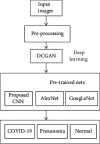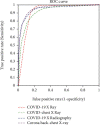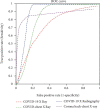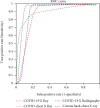Deep Learning Algorithm for COVID-19 Classification Using Chest X-Ray Images
- PMID: 34795794
- PMCID: PMC8594989
- DOI: 10.1155/2021/9269173
Deep Learning Algorithm for COVID-19 Classification Using Chest X-Ray Images
Abstract
Early diagnosis of the harmful severe acute respiratory syndrome coronavirus 2 (SARS-CoV-2), along with clinical expertise, allows governments to break the transition chain and flatten the epidemic curve. Although reverse transcription-polymerase chain reaction (RT-PCR) offers quick results, chest X-ray (CXR) imaging is a more reliable method for disease classification and assessment. The rapid spread of the coronavirus disease 2019 (COVID-19) has triggered extensive research towards developing a COVID-19 detection toolkit. Recent studies have confirmed that the deep learning-based approach, such as convolutional neural networks (CNNs), provides an optimized solution for COVID-19 classification; however, they require substantial training data for learning features. Gathering this training data in a short period has been challenging during the pandemic. Therefore, this study proposes a new model of CNN and deep convolutional generative adversarial networks (DCGANs) that classify CXR images into normal, pneumonia, and COVID-19. The proposed model contains eight convolutional layers, four max-pooling layers, and two fully connected layers, which provide better results than the existing pretrained methods (AlexNet and GoogLeNet). DCGAN performs two tasks: (1) generating synthetic/fake images to overcome the challenges of an imbalanced dataset and (2) extracting deep features of all images in the dataset. In addition, it enlarges the dataset and represents the characteristics of diversity to provide a good generalization effect. In the experimental analysis, we used four distinct publicly accessible datasets of chest X-ray images (COVID-19 X-ray, COVID Chest X-ray, COVID-19 Radiography, and CoronaHack-Chest X-Ray) to train and test the proposed CNN and the existing pretrained methods. Thereafter, the proposed CNN method was trained with the four datasets based on the DCGAN synthetic images, resulting in higher accuracy (94.8%, 96.6%, 98.5%, and 98.6%) than the existing pretrained models. The overall results suggest that the proposed DCGAN-CNN approach is a promising solution for efficient COVID-19 diagnosis.
Copyright © 2021 Sharmila V J and Jemi Florinabel D.
Conflict of interest statement
The authors declare that they have no conflicts of interest.
Figures









References
-
- Han D., Liua Q., Fan W. A new image classification method using CNN transfer learning and web data augmentation. Expert Systems with Applications . 2018;95:43–56. doi: 10.1016/j.eswa.2017.11.028. - DOI
Publication types
MeSH terms
LinkOut - more resources
Full Text Sources
Medical
Miscellaneous

